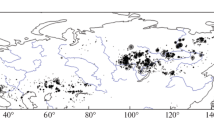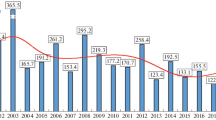Abstract
The results of satellite wildfire monitoring and estimates for the amounts of emissions of harmful gases and fine aerosols in Siberia from 2001 to 2019 are presented. The features of space monitoring used to assess the burned-out areas and the amounts of wildfire emissions are described. The analysis of satellite data processing has allowed us to reveal that the total burned-out areas and the amounts of emissions of harmful gases and fine aerosols in Siberia were abnormally high in 2019. In 2019, 72.4 thousand km2 of Siberia was affected by wildfires, which constituted 42% of the area of wildfires that occurred this year throughout Russia. In 2019, the Irkutsk oblast suffered the most from wildfires in July (11.14 thousand km2) and August (7.24 thousand km2).







Similar content being viewed by others
REFERENCES
Akagi, S.K., Yokelson, R.J., Wiedinmyer, C., Alvarado, M.J., Reid, J.S., Karl, T., Crounse, J.D., and Wennberg, P.O., Emission factors for open and domestic biomass burning for use in atmospheric models, Atmos. Chem. Phys., 2011, vol. 11, pp. 4039–4072. https://doi.org/10.5194/acp-11-4039-2011
Andreae, M.O. and Rosenfeld, D., Aerosol-cloud-precipitation interactions. Part 1. The nature and sources of cloud-active aerosols, Earth Sci. Rev., 2008, vol. 89, pp. 13–41. https://doi.org/10.1016/j.earscirev.03.001
Andreae, M.O. and Merlet, P., Emission of trace gases and aerosols from biomass burning, Global Biogeochem. Cycles, 2001, vol. 15, no 4, pp. 955–966.
Andreeva, I.S., Aerozoli Sibiri (Aerosols of Siberia), no. 9 of Integratsionnye proekty SO RAN (SB RAS Integrative Projects), Novosibirsk: Sib. Otd. Ross. Akad, Nauk, 2006.
Bartalev, S.A., Egorov, V.A., Efremov, V.Yu., Loupian, E.A., Stytsenko, F.V., and Flitman, E.V., Integrated fire area assessment based on combined use of multi-resolution V satellite data, Sovr. Probl. Dist. Zond. Zemli Kosmosa, 2012, vol. 9, no. 2, p. 9-6.
Bondur, V.G. and Chimitdorzhiev, T.N., Texture analysis of radar images of vegetation, Izv. Vyssh. Uchebn. Zaved., Geod. Aerofotos’emka, 2008a, no. 5, pp. 9–14.
Bondur, V.G. and Gordo, K.A., Satellite monitoring of wildfires and their effects in the Northern Eurasia, 17th Int. Multidisciplinary Sci. GeoConf. SGEM 2017 (29 June–5 July 2017, Albena, Bulgaria), pp. 227–238.
Bondur, V.G. and Savin, A.I., Design of a system to monitor the environment for purposes relating to ecology and natural resources, Sov. J. Remote Sens., 1993, vol. 10, no. 6, pp. 1078–1093.
Bondur, V.G. and Starchenkov, S.A., Methods and programs for the processing and classification of aerospace images, Izv. Vyssh. Uchebn. Zaved., Geod. Aerofotos’emka, 2001, no. 3, pp. 118–143.
Bondur, V.G. and Chimitdorzhiev, T.N., Remote sensing of vegetation by optical microwave methods, Izv. Vyssh. Ucheb. Zaved. Geod. Aerofotos’emka, 2008b, no. 6, pp. 64–73.
Bondur, V.G., Aerospace methods and technologies for monitoring oil and gas areas and facilities, Izv., Atmos. Oceanic Phys., 2011a, vol. 47, no. 9, pp. 1007–1018.
Bondur, V.G., Satellite monitoring of wildfires during the anomalous heat wave of 2010 in Russia, Izv., Atmos. Oceanic Phys., 2011b, vol. 47, no. 9, pp. 1039–1048. https://doi.org/10.1134/S0001433811090040
Bondur, V.G. and Vorobev, V.E., Satellite monitoring of impact Arctic regions, Izv., Atmos. Oceanic Phys., 2015, vol. 51, no. 9, pp. 949–968. https://doi.org/10.1134/S0001433815090054
Bondur, V.G. and Ginzburg, A.S., Emission of carbon-bearing gases and aerosols from natural fires on the territory of Russia based on space monitoring, Dokl., Earth Sci., 2016, vol. 466, no. 2, pp. 148–152. https://doi.org/10.1134/S1028334X16020045
Bondur, V.G., Satellite monitoring of trace gas and aerosol emissions during wildfires in Russia, Izv., Atmos. Oceanic Phys., 2016, vol. 52, no. 9, pp. 1078–1091. https://doi.org/10.1134/S0001433816090103
Bondur, V.G., Gordo, K.A., and Kladov, V.L., Spacetime distributions of wildfire areas and emissions of carbon-containing gases and aerosols in Northern Eurasia according to satellite-monitoring data, Izv., Atmos. Oceanic Phys., 2017, vol. 53, no. 9, pp. 859–874. https://doi.org/10.1134/S0001433817090055
Bondur, V.G. and Gordo, K.A., Satellite monitoring of burnt-out areas and emissions of harmful contaminants due to forest and other wildfires in Russia, Izv., Atmos. Oceanic Phys., 2018, vol. 54, no. 9, pp. 955–965. https://doi.org/10.1134/S0001433818090104
Bondur, V.G., Tsidilina, M.N., Kladov, V.L., and Gordo, K.A., Irregular variability of spatiotemporal distributions of wildfires and emissions of harmful trace gases in Europe based on satellite monitoring data, Dokl., Earth Sci., 2019a, vol. 485, pp. 461–464. https://doi.org/10.1134/S1028334X19040202
Bondur, V.G., Tsidilina, M.N., and Cherepanova, E.V., Satellite monitoring of wildfire impacts on the state of different types of vegetation cover in the federal districts of the Russian Federation, Izv., Atmos. Oceanic Phys., 2019b, vol. 55, no. 9, pp. 1238–1253. https://doi.org/10.1134/S000143381909010X
Bondur, V.G., Chimitdorzhiev, T.N., Dmitriev, A.V., and Dagurov, P.N., Spatial anisotropy assessment of the forest vegetation heterogeneity at different azimuth angles of radar polarimetric sensing, Izv., Atmos. Oceanic Phys., 2019c, vol. 55, no. 9, pp. 926–934. https://doi.org/10.1134/S0001433819090093
Dobrykh, V.A. and Zakharycheva, T.A., Dym lesnykh pozharov i zdorov’e (Smoke of Forest Fires and Health), Khabarovsk: Dal’nevost. Gos. Med. Univ., 2009.
Friedl, M.A., Sulla-Menashe, D., Tan, B., Schneider, A., Ramankutty, N., Sibley, A., and Huang, X., MODIS collection 5 global land cover: algorithm refinements and characterization of new datasets, Remote Sens. Environ., 2010, vol. 114, no. 1, pp. 168–182. https://doi.org/10.1016/jrse.2009.08.016
Giglio, L., Schroeder, W., and Justice, C.O., The collection 6 MODIS active fire detection algorithm and fire products, Remote Sens. Environ., 2016, vol. 178, no. 6, pp. 31–41.
Koroleva, T.S., Konstantinov, A.V., and Shunkina, E.A. Threats and socio-economic consequences of climate change for the forest sector), Tr. SPb. Inst. Les. Khoz., 2015, no. 3, pp. 55–71.
Korovin, G.N., Analysis of distribution of forest fires in Russia, in Fires in Ecosystems of Boreal Eurasia, Goldammer, J.G. and Furyaev, V.V., Eds., The Hague: Kluwer Academic, 1996, pp. 112–128.
Kulmala, M., Lappalainen, H.K., Petäjä, T., Kerminen, V.-M., Viisanen, Y., Matvienko, G., Melnikov, V., Baklanov, A., Bondur, V., Kasimov, N., and Zilitinkevich, S., Pan-Eurasian Experiment (PEEX) program: grand challenges in the arctic-boreal context, Geogr. Environ. Sustainability, 2016, no. 2 (9), pp. 5–18. https://doi.org/10.15356/2071-9388_02v09_2016_01
Lappalainen, H.K., Kerminen, V.-M., Petäjä, T., Bondur, V., et al., Pan-Eurasian Experiment (PEEX): Towards a holistic understanding of the feedbacks and interactions in the land–atmosphere–ocean–society continuum in the Northern Eurasian region, Atmos. Chem. Phys., 2016, vol. 16, pp. 14421–14461. https://doi.org/10.5194/acp-16-14421-2016
Lappalainen, H., Petäjä, T., Kujansuu, J., Kerminen, V., Skorokhod, A., Kasimov, N., Bondur, V., et al., Pan-Eurasian Experiment (PEEX) – a research initiative meeting the grand challenges of the changing environment of the northern Pan-Eurasian Arctic-boreal areas, Geogr. Environ. Sustainability, 2014, no. 2 (7), pp. 13–48.
Liu, J.C., Pereira, G., Uhl, S.A., Bravo, M.A., and Bell, M.L., A systematic review of the physical health impacts from non-occupational exposure to wildfire smoke, Environ. Res., 2015, vol. 136, pp. 120–132.
Seiler, W. and Crutzen, P.J., Estimates of gross and net fluxes of carbon between the biosphere and atmosphere from biomass burning, Clim. Change, 1980, vol. 2, no. 3, pp. 207–247.
Solovyev, V.S., Kozlov, V.I., and Mullayarov, V.A., Distantsionnyi monitoring lesnykh pozharov i groz v Yakutii (Remote Monitoring of Forest Fires and Thunderstorms in Yakutia), Yakutsk: Yakut. Nauch. Tsentr Ross. Akad. Nauk, 2009.
Solovyev, V.S. and Budishchev, A.A., Disturbances of aerosol optical thickness of the atmosphere caused by forest fires in Yakutia, Atmos. Oceanic Opt., 2010, vol. 23, no. 6, pp. 538–541.
Tian, B., Manning, E., Fetzer, E., Olsen, E., Wong, S., Susskind, J., et al., AIRS/AMSU/HSB Version 6 Level 3 Product User Guide (Pasadena, CA: Jet Propulsion Lab., 2013).
Tomshin, O.A., Protopopov, A.V., and Solovyev, V.S., Study of atmospheric aerosol and carbon monoxide variations over forest fires, Sovr. Probl. Dist. Zond. Zemli Kosm., 2012, vol. 9, no. 1, pp. 145–150.
Tomshin, O.A. and Solovyev, V.S., Features of forest fire activity in boreal forests of the permafrost region of Eastern Siberia, Sovr. Probl. Dist. Zond. Zemli Kosm., 2018, vol. 15, no. 1, pp. 261–271.
Vivchar, A.V., Moiseenko, K.B., and Pankratova, N.V., Estimates of carbon monoxide emissions from wildfires in northern Eurasia for air quality assessment and climate modeling, Izv., Atmos. Oceanic Phys., 2010, vol. 46, no. 3, pp. 281–293.
Wiedinmyer, C., Akagi, S.K., Yokelson, R.J., Emmons, L.K., Al-Saadi, J.A., Orlando, J.J., and Soja, A.J., The Fire Inventory from NCAR (FINN) – a high resolution global model to estimate the emissions from open burning, Geosci. Model Dev. Discuss., 2010, vol. 3, pp. 2439–2476.
Funding
This study was supported by the Russian Foundation for Basic Research, MOST (China), and DST (India) (project no. 19-55-80021).
Author information
Authors and Affiliations
Corresponding author
Additional information
Translated by V. Arutyunyan
Rights and permissions
About this article
Cite this article
Voronova, O.S., Zima, A.L., Kladov, V.L. et al. Anomalous Wildfires in Siberia in Summer 2019. Izv. Atmos. Ocean. Phys. 56, 1042–1052 (2020). https://doi.org/10.1134/S000143382009025X
Received:
Revised:
Accepted:
Published:
Issue Date:
DOI: https://doi.org/10.1134/S000143382009025X




